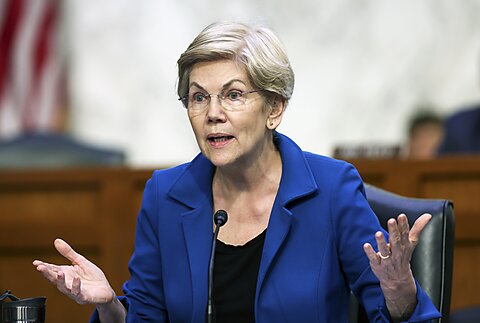
Jack Solowey and Jennifer J. Schulp
Following Hamas’s blood‐soaked atrocities in the State of Israel, Senators Elizabeth Warren (D‑MA) and Roger Marshall (R‑KS) have sought to use the October 7 pogrom to gain support for a bill purporting to combat cryptocurrency’s use in financing terror and other crimes.
While the full extent and impact of Hamas’s use of cryptocurrency involves ongoing investigation, we want to leave no room for doubt about the reprehensibility of Hamas’s terror against innocent men, women, and children, including, in the words of President Biden, “Children slaughtered. Babies slaughtered. Entire families massacred. Rape, beheadings, bodies burned alive.”
As for the Warren‐Marshall crypto anti‐money laundering (AML) bill that’s being shopped as a response to this terrorism, it’s bad public policy that would, in essence, grant terrorists veto power over the lawful use of technology.
What We Do and Don’t Know About Hamas’s Use of Cryptocurrency
In general, cryptocurrency is not believed to be terrorists’ primary financial tool. According to the US Treasury Department’s 2022 National Terrorist Financing Risk Assessment, “terrorist use of virtual assets appears to remain limited when compared to other financial products and services.” Similarly, the Treasury Department’s 2023 Illicit Finance Risk Assessment of Decentralized Finance concluded that “money laundering, proliferation financing, and terrorist financing most commonly occur using fiat currency or other traditional assets as opposed to virtual assets.”
At Thursday’s (Oct. 26) Senate Banking Committee hearing on “Combating the Networks of Illicit Finance and Terrorism,” witness Dr. Shlomit Wagman—the former Chair of the Israel Money Laundering and Terror Financing Prohibition Authority—put it powerfully:
Let’s not lose sight and focus from the big picture. Crypto is currently a very small part of the puzzle. The major funding channels are, were, and remain state funding. Iran and others, those are the major players. Most of the funds are still being transferred by the traditional channels that we all know from the past: banks, money transmitters, payment systems, hawala, money exchange, trade‐based terrorism financing, charity, cash, shell companies, and crypto.
This appears to track with respect to Hamas specifically. The terrorist group has used cryptocurrency as only one of many financial tools, fundraising vehicles, and money‐transfer methods, including fiat currency—in cash and through banks—credit cards, hawalas (informal banking networks relying on credit, cash, and barter), taxation within Gaza, misappropriation of (and indirect subsidies from) humanitarian aid, and investment assets. In addition, Hamas uses webs of shell companies, non‐profit foundations, and NGOs to conceal its financial activity—methods that long predate crypto’s existence.
An October 10 article in the Wall Street Journal stated that between approximately August 2021 and June 2023, crypto wallets connected with Hamas received around $41 million worth of crypto, based on research from the Israel‐based crypto analytics firm BitOK, and that wallets linked by Israeli law enforcement to Palestinian Islamic Jihad (PIJ)—a terrorist organization that participated in the October 7 attacks alongside Hamas—received up to $93 million worth of crypto, based on research by Elliptic, another analytics firm.
Notably, Elliptic has since disputed this characterization in an October 25 post. Regarding the claim that Hamas and PIJ raised over $130 million in crypto, Elliptic stated, “there is no evidence to suggest that crypto fundraising has raised anything close to this amount, and data provided by Elliptic and others has been misinterpreted.” The Wall Street Journal has subsequently updated the October 10 article to note that “Elliptic says it isn’t clear if all of the transactions it identified directly involved PIJ, because some of the wallets belonged to crypto brokers that may have also served non‐PIJ clients.”
Relatedly, in an October 18 post, Chainalysis (another crypto analytics firm) had provided additional context for Hamas‐linked crypto numbers being floated. While not calling out any specific report or source by name, Chainalysis discussed how “recent estimates” of crypto activity following Hamas’s attack may significantly overestimate the funds in the hands of terrorists, as such figures appeared to Chainalysis to include all funds flowing through service providers, not merely the explicitly terror‐related funds. According to Chainalysis, the known terror‐related funds flowing through service providers could be a small fraction of the overall funds those service providers process.
When trying to make sense of reports regarding terrorist‐linked crypto funds and the relevant caveats, one consideration to bear in mind is that policymakers and law enforcement agencies have different missions—or at least they should. As the Chainalysis post notes, two things can be true at the same time: (1) where service providers specifically serve as terrorist facilitators, “cutting off terrorist access to them” can be an important law enforcement tactic and (2) it may be “incorrect to assume” that all activity of a service provider used by terrorists is terror‐related. When policymakers fail to understand these nuances, they can end up overstating the relative role that cryptocurrency plays in terror finance.
Additional assumptions regarding the relationship between cryptocurrency and terror finance can include the faulty notion that crypto is somehow a universally untraceable financial silver bullet for terrorists. However, because cryptocurrency transactions settle on open, public ledgers, they produce more of a traceable record than cash does. And while there are privacy‐enhancing cryptocurrencies and applications, as George Mason University law professor J.W. Verrett explained in a recent Wall Street Journal commentary, such privacy tools “have limited transaction capacities,” making them ill‐suited to largescale transfers.
Moreover, while self‐custodied crypto assets can resist seizure where law enforcement lacks access to the relevant user and/or device, cryptocurrencies that are housed with intermediaries (in one form or another) can be, and have been, interdicted. In 2020, the U.S. Department of Justice seized hundreds of crypto accounts related to the financing of al‐Qaeda, ISIS, and Hamas. Since 2021, Israel’s National Bureau for Counter‐Terror Financing (NBCTF) reportedly confiscated nearly 200 crypto accounts alleged to be linked to ISIS and Hamas. In 2023, the NBCTF seized millions of dollars’ worth of crypto related to Hezbollah and Iran’s Quds Force. And in the days following the October 7 massacre, the investigations division of the Israeli Police—Lahav 433—stated that they froze certain Hamas crypto accounts.
Dr. Wagman has noted that such seizures address only a fraction of Hamas‐linked crypto. But that claim should not be mistaken for the separate claim, which Wagman herself debunks, that crypto is an outsized terror finance tool compared to other financial instruments.
In fact, in the face of challenges like crypto asset seizures, Hamas announced in April 2023 that they would stop raising funds with Bitcoin to protect their donors. And although subsequent crypto fundraising efforts in support of Hamas have been identified since October 7, early reports suggest those have raised only minimal funds, and some already have been frozen.
Perhaps one of the best summaries of the crypto landscape’s complex mix of both opportunities and challenges for counterterrorism was stated by Ari Redbord, Global Head of Policy at TRM Labs (a crypto analytics firm): “Crypto and illicit finance is a paradox to some extent. We do have more visibility than before, but don’t have the full visibility.”
The Warren‐Marshall Bill Is Bad Public Policy
Senators Warren and Marshall have couched their bill—the Digital Asset Anti‐Money Laundering Act of 2023—as a common‐sense effort to fill loopholes and “apply the same anti‐money‐laundering rules to crypto that already apply to banks, brokers, check cashers and even precious‐metal dealers.”
This is a gross mischaracterization. Their bill is not designed to fill loopholes but rather gum up the works of the US crypto ecosystem and risk forcing it offshore (and outside the reach of US law).
It’s misleading to suggest that the parts of the crypto ecosystem that are most analogous to banks and brokers—i.e., centralized, custodial crypto exchanges that allow users to buy and sell crypto with fiat money—don’t already face AML rules in the US. Typically, these businesses (so‐called “fiat on/off ramps”) are considered money transmitters and “money services businesses,” which are subject to a suite of federal AML and Know Your Customer (KYC) regulations under the Bank Secrecy Act (BSA)—including requirements to register with the Treasury Department, maintain AML programs, verify customers’ identification, employ compliance personnel, report transactions in currency over $10,000, and report suspicious activity. Coinbase, for example, plainly states on its website that it’s required to comply with the BSA, and is quite open about its approach to combatting terror financing.
The Warren‐Marshall bill would go much further than simply ensuring that like rules are applied to like institutions. By defining digital asset miners and validators—which constitute the computing infrastructure securing cryptocurrency networks and do not directly interface with transacting parties—as “financial institutions” subject to AML/KYC requirements, the bill would place obligations to identify customers and their financial activity on entities for whom this simply wouldn’t make sense and who are incapable of doing so.
The result would be, in essence, a de facto ban on operating the backbone of the crypto ecosystem within the US. (Unfortunately, imposing de facto bans on US crypto activity by subjecting the square peg of crypto technology to the round hole of legacy regulatory frameworks has been a hallmark of the US regulatory approach to date.)
As Ben Samocha, co‐founder of a number of Israeli crypto projects, including Crypto Aid Israel (a project raising money for the victims of Hamas terror and their families), put it “[c]rypto is here to stay.” Creating unworkable laws in the US would not uninvent crypto, it simply would route it through other jurisdictions and make it impractical for law‐abiding US citizens to use (for example, to donate to humanitarian projects like Crypto Aid Israel). It’s unclear how driving crypto activity offshore would benefit or protect the US and its allies.
Don’t Give Terrorists the Destroyer’s Veto
Ultimately, crypto technology is a particular type of tool: infrastructure. In a sense, it’s a tool to build other tools. Perhaps unsurprisingly, Israel—nicknamed the Start‐up Nation—is home to hundreds of crypto startups.
It is, of course, true that one person’s tool is another person’s weapon. Indeed, there’s a salient analogy here: Hamas reportedly has used water pipes—another form of infrastructure—not to irrigate but to manufacture rockets to fire at civilians. Destruction is terrorists’ vocation, and terrorists should not be granted veto power over those using technology to build.
One constructive application of crypto technology has been to use its underlying tamper‐resistant recordkeeping system to securely document the testimony of Holocaust survivors. We personally could think of few more fitting applications of this idea than securely recording the evidence and testimonies of survivors of Hamas’s October 7 pogrom—the deadliest attack on the Jewish people since the Holocaust. Legislation that would render any use of crypto technology legally untenable would make such projects securing all‐too‐necessary witness to atrocities practically unworkable.
While investigations into the full extent of Hamas’s use of all financial tools, crypto included, should continue—just last week both the House Financial Services Committee and Senate Banking Committee held hearings on terror finance, for example—US policy should not give terrorists the right to deny technology to those using it to lawfully and constructively build.




